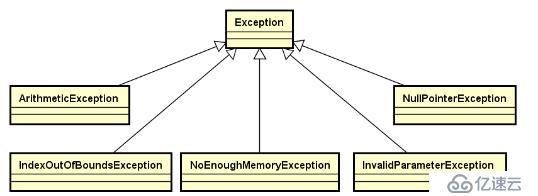C++内置了异常处理的语法元素try.....catch.....
1.try语句处理正常代码逻辑
2.catch语句处理异常情况
3.try语句中的异常由对应的catch语句处理
常见的语句如下
try
{
double r=divide(1,0);
}
catch(...)
{
cout<<"the result..."<<endl;
}C++通过throw语句抛出异常信息
double divide(double a,double b)
{
const double delta=0.00000000001;
double ret=0;
if(!((-delta<b)&&(b<delta)))
{
ret=a/b;
}
else
{
throw 0;//产生除0异常
}
return ret;
}C++异常处理分析
throw抛出的异常必须被catch处理--当前函数能够处理异常,程序机械往下执行,当前函数无法处理异常,则函数停止执行,并返回.未被处理的异常会顺着函数调用栈向上传播,直到被处理为止,否则程序将停止执行
//代码示例
#include <iostream>
using namespace std;
double divide(double a, double b)
{
const double delta = 0.000000000000001;
double ret = 0;
if( !((-delta < b) && (b < delta)) ) {
ret = a / b;
}
else {
throw 0; // 产生除 0 异常
}
return ret;
}
void Demo1()
{
try
{
throw 'c';
}
catch(int i)
{
cout << "catch(int i)" << endl;
}
catch(double d)
{
cout << "catch(double d)" << endl;
}
catch(char c)
{
cout << "catch(char c)" << endl;
}
}
void Demo2()
{
throw 0.0001; // "D.T.Software"; // const char*
}
int main()
{
cout << "main() begin" << endl;
try
{
double c = divide(1, 1);
cout << "c = " << c << endl;
}
catch(...)
{
cout << "Divided by zero..." << endl;
}
Demo1();
try
{
Demo2();
}
catch(char* c)
{
cout << "catch(char* c)" << endl;
}
catch(const char* cc)
{
cout << "catch(char* cc)" << endl;
}
catch(...)
{
cout << "catch(...)" << endl;
}
cout << "main() end" << endl;
return 0;
}
异常的类型可以是自定义类类型,对于类类型异常的匹配依旧是至上而下严格匹配,赋值兼容性原则在异常匹配中依然适用
异常类的功能定义
| 异常类 | 功能定义 |
|---|---|
| ArithmeticException | 计量异常 |
| NullPointerException | 空指针异常 |
| IndexOutBoundsException | 越界异常 |
| NoEnoughMemoryException | 内存不足异常 |
| InvaildParameterException | 参数异常 |

#ifndef EXCEPTION_H
#define EXCEPTION_H
/*
异常的类型可以是自定义类类型
对于类类型异常的匹配依旧是至上而下严格匹配
一般而言
匹配子类异常的catch放在上部
匹配父类异常的catch放在下部
*/
#include "Object.h"
namespace MyLib
{
//定义宏THROW_EXCEPTION,抛出异常时直接写异常类型及异常信息即可
#define THROW_EXCEPTION(e, m) (throw e(m, __FILE__, __LINE__))
class Exception:public Object
{
protected:
char* m_message;//异常的信息
char* m_location;//异常的位置
void init(const char* message,const char *file,int line);
public:
Exception(const char* message);
Exception(const char *file,int line);
Exception(const char* message,const char *file,int line);
Exception(const Exception& e);
Exception& operator=(const Exception& e);
virtual const char* message()const;
virtual const char* location()const;
virtual ~Exception();//纯虚函数
};
class ArithmeticException : public Exception
{
public:
ArithmeticException():Exception(0){}
ArithmeticException(const char* message):Exception(message){}
ArithmeticException(const char* file,int line):Exception(file,line){}
ArithmeticException(const char*message,const char*file,int line):Exception(message,file,line){}
ArithmeticException(const ArithmeticException& e):Exception(e){}//拷贝构造函数
ArithmeticException&operator =(const ArithmeticException& e)
{
Exception::operator =(e);
return *this;
}
};
class NullPointerException : public Exception
{
public:
NullPointerException():Exception(0){}
NullPointerException(const char* message):Exception(message){}
NullPointerException(const char* file,int line):Exception(file,line){}
NullPointerException(const char*message,const char*file,int line):Exception(message,file,line){}
NullPointerException(const NullPointerException& e):Exception(e){}//拷贝构造函数
NullPointerException&operator =(const NullPointerException& e)
{
Exception::operator =(e);
return *this;
}
};
class indexOutOfBoundsException : public Exception
{
public:
indexOutOfBoundsException():Exception(0){}
indexOutOfBoundsException(const char* message):Exception(message){}
indexOutOfBoundsException(const char* file,int line):Exception(file,line){}
indexOutOfBoundsException(const char*message,const char*file,int line):Exception(message,file,line){}
indexOutOfBoundsException(const indexOutOfBoundsException& e):Exception(e){}//拷贝构造函数
indexOutOfBoundsException&operator =(const indexOutOfBoundsException& e)
{
Exception::operator =(e);
return *this;
}
};
class NoEoughMemoryException : public Exception
{
public:
NoEoughMemoryException():Exception(0){}
NoEoughMemoryException(const char* message):Exception(message){}
NoEoughMemoryException(const char* file,int line):Exception(file,line){}
NoEoughMemoryException(const char*message,const char*file,int line):Exception(message,file,line){}
NoEoughMemoryException(const NoEoughMemoryException& e):Exception(e){}//拷贝构造函数
NoEoughMemoryException&operator =(const NoEoughMemoryException& e)
{
Exception::operator =(e);
return *this;
}
};
class InvalidOperationException : public Exception
{
public:
InvalidOperationException():Exception(0){}
InvalidOperationException(const char* message):Exception(message){}
InvalidOperationException(const char* file,int line):Exception(file,line){}
InvalidOperationException(const char*message,const char*file,int line):Exception(message,file,line){}
InvalidOperationException(const InvalidOperationException& e):Exception(e){}//拷贝构造函数
InvalidOperationException&operator =(const InvalidOperationException& e)
{
Exception::operator =(e);
return *this;
}
};
class InvalidParameterException : public Exception
{
public:
InvalidParameterException():Exception(0){}
InvalidParameterException(const char* message):Exception(message){}
InvalidParameterException(const char* file,int line):Exception(file,line){}
InvalidParameterException(const char*message,const char*file,int line):Exception(message,file,line){}
InvalidParameterException(const InvalidParameterException& e):Exception(e){}//拷贝构造函数
InvalidParameterException&operator =(const InvalidParameterException& e)
{
Exception::operator =(e);
return *this;
}
};
}
#endif // EXCEPTION_H三 顶层父类的创建
创建顶层父类的意义--遵循经典设计准则,所有的数据都继承Object类,定义动态内存申请的行为,提高代码的移植性
顶层父类的接口定义
class Object
{
public:
void* operator new(unsigned int size)throw();
void operator delete(void* p);
void* operator new[](unsigned int size)throw();
void operator delete[](void* p);
~Object();
};
/*
Object类是所写的顶层父类
Object类用于统一内存申请的行为
在堆中创建Object子类的对象,失败时返回NULL值
Object类为纯虚父类,所有子类都能进行动态类型识别
*/免责声明:本站发布的内容(图片、视频和文字)以原创、转载和分享为主,文章观点不代表本网站立场,如果涉及侵权请联系站长邮箱:is@yisu.com进行举报,并提供相关证据,一经查实,将立刻删除涉嫌侵权内容。